3.1: Planning Happens in a Cycle
To begin to understand how to plan effective, developmentally appropriate curriculum for children, we must look at the context in which that planning should happen. Planning everything, from the flow of the day, to how teachers design and stock the classroom environment, to the way the spontaneous (unplanned) experiences of children are recognized and valued, to the experiences teachers thoughtfully plan and intentionally implement, happens in a continuous cycle. As we will discuss in this chapter that cycle begins with observing and continues through documenting what was observed, reflecting on what it means and how to plan to best support children, and then implementing those plans, before returning back to observing.[1]
Planning curriculum for young children begins with teachers discovering, through careful listening and observation, each child’s development. Observation is an essential skill for a teacher. When teachers mindfully observe, they discover how individual children make meaning in everyday moments of play and interactions and how to deepen their relationships with children. Observing for the purpose of assessing individual children’s learning means carefully watching and listening, with thought and reflection. In doing so, teachers find the knowledge, awareness, and strategies that individual children have formed during their experiences. It may be evidence that pertains to individual children’s emotional, social, cognitive, or physical development. If the evidence is clear and significant, teachers can preserve it through, for example, a note, a photo, or a sample of a child’s work.
Consider this example in which teachers found various ways in which the children’s engagement in learning about snails related to the developmental profiles of different children:
As the children’s interest in the snails continued, the teachers looked for ways to expand learning opportunities and integrate them into the multifaceted experience. The teachers also reviewed individual children’s developmental profiles to be mindful of children’s developmental progress in different areas. In addition to the many counting opportunities in the environment, the teachers decided to integrate counting into the children’s exploration of snails. Younger children who were making progress with learning to count objects between five and ten were invited to set up a specific number (less than ten) of trays and snails.
Before the children started, the teachers reminded them of an earlier conversation about how to care for snails. In response, one of the children asked to show the others how to handle the snails gently. (Learning about counting was happening at the same time as learning about controlling the impulse to handle other creatures roughly instead of being gentle with them.) Teachers suggested to other children who were continuing to make progress with counting to count out a quantity of sticks, bark, or leaves greater than ten. Other children were asked to divide the snails evenly between the trays. The children kept saying to themselves, “Be gentle,” and handled the snails with great care.

As teachers observed each group, they helped children develop mathematical thinking by prompting them and asking questions. For example, at one table, a teacher noticed that children were counting some sticks twice. She said, “I wonder what would happen if we put each stick on the other side of the tray after counting it.” The children tried out this idea. Teachers noted children’s efforts and placed the notes, with the date recorded, into the children’s individual portfolios to be used as evidence for later reference when considering developmental progress relating to number sense and impulse control.
As teachers observe children’s play and interactions, they discover ways to support children’s learning. Ideas for the next steps in curriculum planning emerge as teachers reflect on how they might extend or expand children’s thinking, language, and interactions. Observation, reflection, and documentation in the moment simultaneously launch an ongoing assessment of each child’s progress in learning as well as the curriculum planning cycle.[2]
Here is a visual representation of the Curriculum Planning Cycle

Let’s explore each part of the cycle.
Observe
Observation means being present with children and attentive as they play and interact with others and the environment. This mindful kind of presence is different from participating in children’s play or directing their play. Whether for one minute or five, an attentive, mindful presence means waiting to see what unfolds in order to gain a complete picture of children’s play. A teacher who observes children as a first step in supporting learning discovers small scientists at work—experimenting, comparing, making assumptions, evaluating assumptions through their actions. Over time, children build mastery of a wide range of concepts and skills. The vignette about the snail exploration illustrates the role of the teacher as observer:
During small-group time with the snails, the teacher noticed a child who had been reluctant to hold a snail. This child had a visual impairment. As the teacher gently placed a snail on this child’s hand, two children watched and listened as the teacher commented, “He’s sticking his head out now, and he’s turned toward your fingers. Can you feel him crawling toward your fingers?” The other children who had been watching intently began to repeat the teacher’s encouraging words, saying, “He’s sticking his head out. He’s going toward your fingers!”
The teacher wrote down her observations and added an interpretive note that the children’s behavior may be a growing sign of empathy as measured by the DRDP, and the other child’s willingness to hold the snail, a growing sign of curiosity and initiative, also a DRDP measure.[3]
Observation Happens Through Lenses
It takes practice to become a good observer. An important aspect of being a good observer involves becoming aware of what is noticed and how observations are interpreted. Children may be influenced by many things. Culture, temperament, personal experiences, professional knowledge, and even community values and messages in the media affect how teachers see and experience children. These “lenses” through which teachers observe and interpret are at work even though they may not always be conscious of them.[4]
The Importance of Accuracy
Observations about children should be factual and objective to be useful and meaningful. Teachers should document only what they see and hear (the facts) and avoid using words that communicate judgment about a child’s feelings, intentions, and motivations; are ambiguous and open to interpretation; or describe an opinion. One way teachers may think about their own objectivity is to ask themselves: Am I describing this child’s behaviors and interactions in the same or a similar way that someone else observing this child would describe them?
Interpreting the meaning of children’s behaviors and interactions is important, and impressions, feelings, and insights about children are extremely valuable to the individualizing process. However, teachers first need accurate, factual information in order to draw conclusions later on about children’s skills, behavior, interests, and needs.[5]
Pause to Reflect
Document
Documenting means gathering and holding evidence of children’s play and interests for future use. A common form of documentation in early childhood settings is a written note, often referred to as an observation anecdote. Anecdotal notes, along with other forms of documentation, in particular photos, video recordings, and work samples, serve a dual purpose. First, they preserve a teacher’s observations of children’s expressions of feelings, their thinking, and their learning. These documentations are guides to the next steps in day-to-day curriculum planning. And second, anecdotal notes and other evidence can be used to support a teacher’s periodic assessment of a child’s progress. An episode during the snail exploration highlights the dual purpose of documentation:

Documenting What is Observed
Teachers must be intentional about capturing and recording what children do and say by setting up a system for carrying out observations. There is no one right way to do this. Systems will look different from program to program, and even classroom to classroom. Additionally, observation systems are not static; they should be revisited as teachers become more proficient in observing children and as children grow and develop. However, there are some general strategies that should be considered when developing a system.
- Plan times to observe each child regularly and over time. This should include observing children
- Across settings (e.g., indoor and outdoor) and times of the day (morning, afternoon)
- During routines (e.g., mealtimes, naptime, arrival/departure, transitions)
- As they engage in spontaneous play experiences and planned activities and experiences
- As they interact with other children and adults.

- Plan for spontaneous observation opportunities, too.
- Have materials at hand to capture unexpected, but valuable observations of children.
- Decide how to organize and store observations with the system that works best for the individual teacher or teaching team. For example:
- A file folder for each child kept in hanging files in file cabinet, large box, or crate
- Index cards in file box with a section for each child
- A 3-ring binder notebook for each child
- An accordion folder for each child
- Hanging shoe bag, with pockets labeled for each child
- Decide how often to review observations. A system for using the valuable date from observations is an important part of the curriculum cycle. Some curriculum planning may be easy to implement based on just casual observation. But deeper analysis of observation of individual and groups of children will likely lend valuable insight in what teachers can plan to support optimal development.
- Include families in this process. Invite them to share what they observe about their children verbally, through pictures and photographs, or in writing.[7]
Portfolios
One way to document children’s development and learning are portfolios. Portfolios are collections of children’s work, notes and photographs from families, checklists and other print recording tools, and other items that document what children know and can do. Written observation notes, photos, and audio and video files may be included as part of the portfolio. Portfolios may be physical, virtual (some online assessment tools allow users to input observation notes and upload photos, video, and audio files for each child), or a combination of both.
To be useful, portfolio items should:
- Be dated and filed in order
- Represent various parts of the program (e.g., routines, play experiences, transitions)
- Present a balanced view of the child’s growth in all developmental domains.
Over time, the portfolio collection serves as a concrete record of the child’s progress toward individual goals as well as the program’s school readiness goals, so it should be reviewed regularly with families. Teachers should explain what they include in the portfolio and why they include it. They should also actively encourage families to contribute information and items to their child’s portfolio.[8]
Pause to Reflect
As you think about how to document children’s learning, what systems do you find most appealing? Which do you think would be most effective? Which are least appealing or do you think would be least effective?
Reflect & Plan
As teachers reflect on children’s play, they discover possibilities for designing curriculum to sustain, extend, and help children’s play to be more complex and, consequently, support the children’s continuing learning.[9]
Teachers ask themselves questions about what the information they have documented in observations of children says about the children’s development, interests, and needs. The answers to these questions lead to individualizing care and learning. There are many questions that teachers may ask themselves. For example:
- What developmental skill or activity does the child appear to be working on?
- What strategies does the child use to play with different toys?
- Does the child engage with objects or people differently than a month ago? What has changed? What has not changed?
- Do my actions/the actions of other adults who interact with the child affect the outcomes of the child’s experience? How so?
- How does the information relate to goals for the child? The family’s goals? The program’s school readiness goals?
- What other information do I need?
- What questions do I have for the child’s family?
It is during the reflective process that interpreting the meaning of children’s behaviors and interactions becomes important. These interpretations and insights give rise to each child’s story. Each child’s story informs responsive practice.
Teachers use what they know about each child to
- Adapt the environment
- Modify the daily schedule and/or routines
- Make decisions about how to guide the children’s learning based on what the child knows and can do as well as what the child is ready to try.[10]
That process of reflections then informs possible next steps in the curriculum. Possible steps might include adding materials to interest areas, books to read with large or small groups, activities to do in small groups, or a topic to investigate over time with the children. With clear ideas or objectives in mind, teachers plan curriculum that includes strategies to enhance the learning of all children in a group, as well as strategies to support the learning of individual children. Here is how reflection, discussion, and planning worked in the snail exploration:

Pause to Reflect
Think back to something in your childhood that you were passionately interested or engaged in that someone observing you could have documented. What questions could your teachers have asked themselves about your experiences? How could they have planned?
(If it’s easier or more relevant, you can think of a child you know and consider what you can ask yourself and plan around what you know about that child.)
Implement
Once a plan is written, teachers implement it. While implementing a plan, teachers observe, reflect, and document. The curriculum-planning cycle begins again (or continues) as teachers watch to discover how children respond to the planned curriculum and how children show evidence of their development during the planned learning encounters. Teachers often approach this step with a sense of wonder, for they may be surprised and amazed by the children’s responses.
To hold the responses in memory, teachers may record notes, take a photo, or label, date, and keep a work sample, all of which they can later review to assess the impact of the curriculum plans. The evidence collected will help teachers to come up with ideas for supporting and assessing the children’s learning. Teachers might ponder the following questions:
- Are children responding as predicted, or were there surprises?
- What do the children’s responses tell us? How might we name the children’s interest(s) or intention(s)? What concepts and ideas are the children forming within their play?
- How might children who are English learners and children who speak English collaborate in small groups to learn from one another?
- Are children showing evidence of progress on any of the measures of the DRDP?
Here is what happened when the teachers implemented their idea of going on walks with the children to find snails in natural habitats:
Before going on their snail hunt, a small group of children gathered on a blanket with the teacher. Each child was provided with a clipboard with paper for taking “notes” while the teacher explained how the walk would be a way to find snails that lived outside their classroom. Some children pretended to write while the teacher talked, while others drew pictures of snails. In this group, teachers included two children who were fluent in Spanish and learning English. The teachers anticipated much conversation among children during the search for the snails and wanted to give these children a chance to converse in their home language as well as to share experiences with peers who spoke only English.

Before heading off on the hunt, the teacher suggested, “Let’s estimate. How many snails do you think we will find? Each of you can guess.” On a large sheet of paper that the children could easily see, she wrote each child’s name, saying each letter as she did so, and next to each name, the number guessed by that child.
Armed with magnifying glasses, the children went off to collect snails. There were many discoveries along the walk, not just snails. As children found snails, they carried them to a large examination tray set up on a table. Some children took a break from their snail search to examine, touch, and draw the snails already collected. At the end of the hunt, the children lined up the snails on a small log and counted them. The teacher suggested that they compare the number they counted with their estimates.
Before returning to their classroom, the children put the snails back into their natural habitats. The children were excited about sharing their experiences with other teachers and peers when they returned.
The teachers examined and reflected on what they saw in the children’s writings and drawings on the clipboards. They decided that some of the work samples were significant in showing how individual children were developing an idea, concept, or skill. They filed those samples in the children’s portfolios as evidence of developmental progress.[12]
Pause to Reflect
What happens when implementation goes differently than expected? What would have happened if the children had discovered and become fascinated with dandelions on their hunt for snails (and subsequently lost interest in the snails)? Does curriculum have to go as planned? Why or why not?
- Content by Jennifer Paris is licensed under CC BY 4.0 ↵
- California Preschool Curriculum Framework, Volume 1 by the California Department of Education is used with permission (pg. 19-20) ↵
- California Preschool Curriculum Framework, Volume 1 by the California Department of Education is used with permission ↵
- Observation: The Heart of Individualizing Responsive Care by the Office of Head Start is in the public domain ↵
- Observation: The Heart of Individualizing Responsive Care by the Office of Head Start is in the public domain (pg. 9) ↵
- California Preschool Curriculum Framework, Volume 1 by the California Department of Education is used with permission (pg. 21) ↵
- Observation: The Heart of Individualizing Responsive Care by the Office of Head Start is in the public domain ↵
- Ibid. ↵
- California Preschool Curriculum Framework, Volume 1 by the California Department of Education is used with permission ↵
- Observation: The Heart of Individualizing Responsive Care by the Office of Head Start is in the public domain ↵
- California Preschool Curriculum Framework, Volume 1 by the California Department of Education is used with permission ↵
- Ibid. ↵

